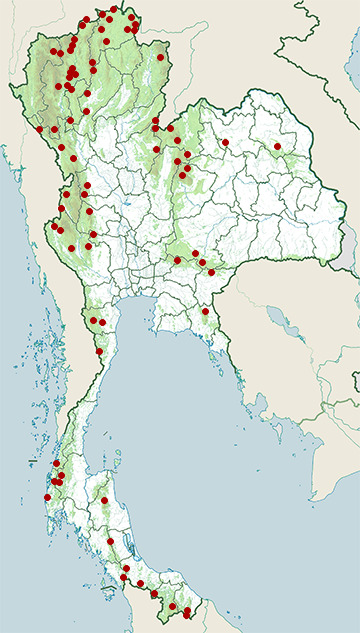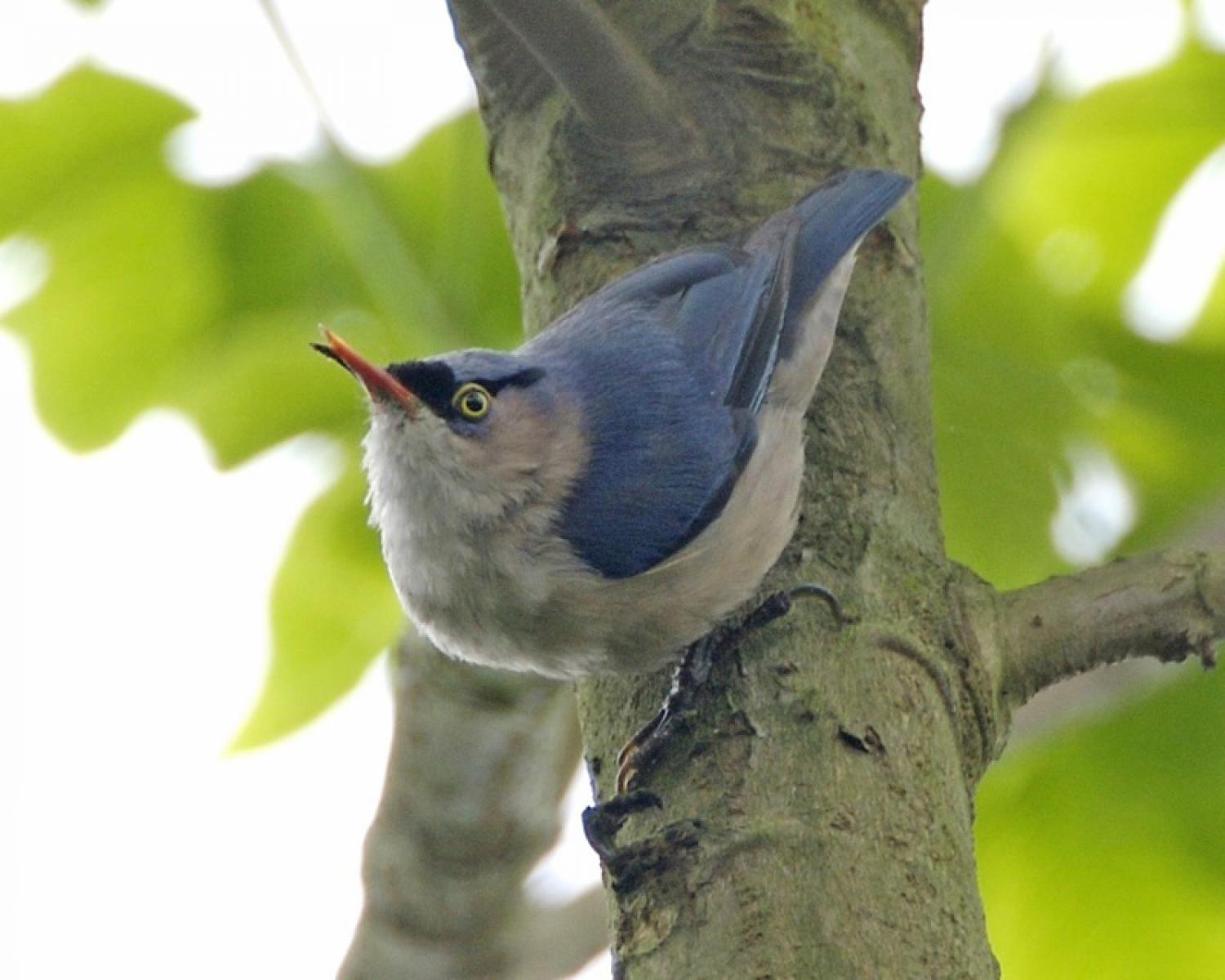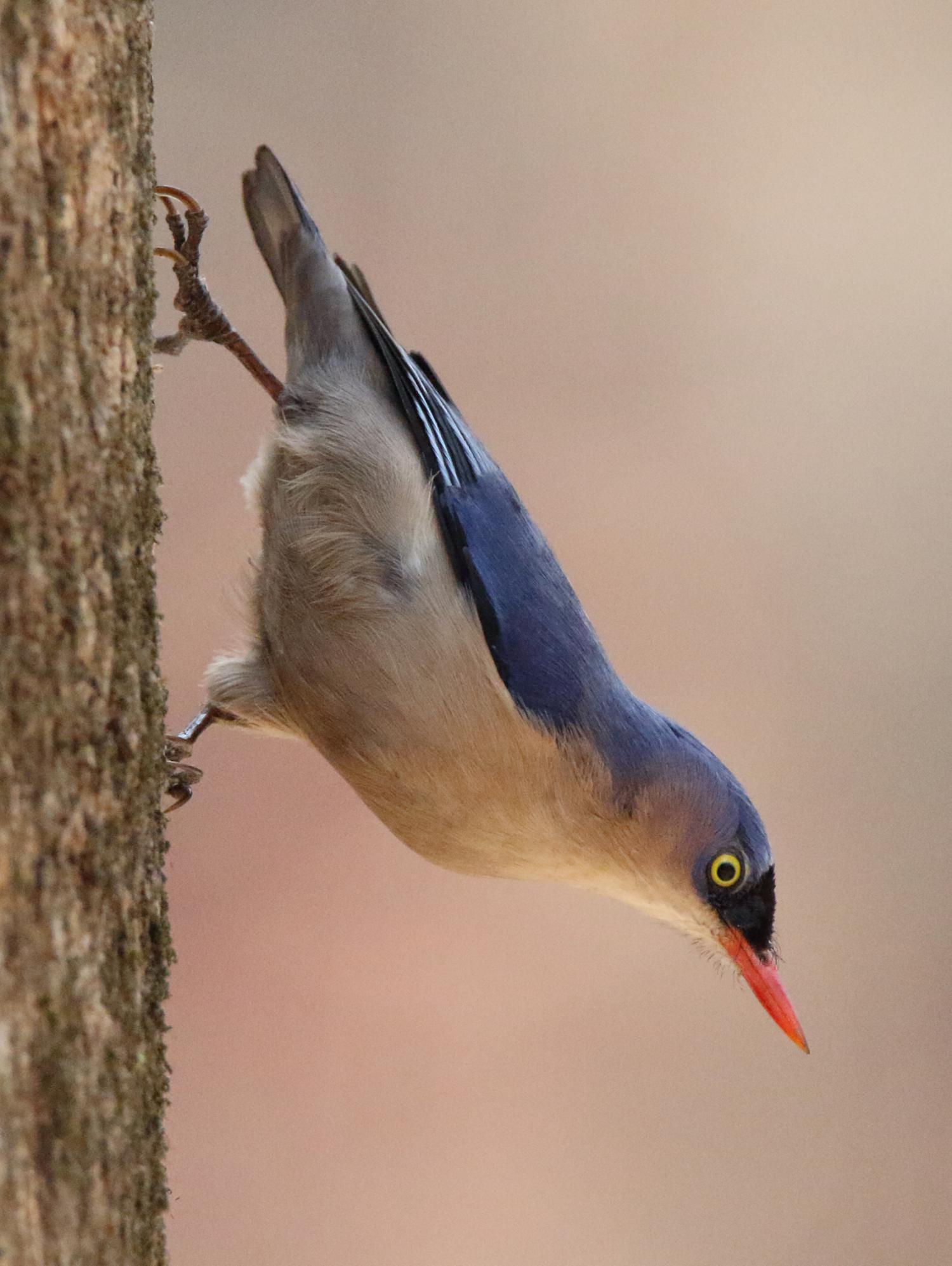Species of Thailand
Velvet-fronted nuthatch
Sitta frontalis
William John Swainson, 1820
In Thai: นกไต่ไม้หน้าผากกำมะหยี่
The velvet-fronted nuthatch (Sitta frontalis) is a small passerine bird in the nuthatch family Sittidae found in southern Asia from Nepal, India, Sri Lanka and Bangladesh east to south China and Indonesia. Like other nuthatches, it feeds on insects in the bark of trees, foraging on the trunks and branches and their strongly clawed toes allow them to climb down tree trunks or move on the undersides of horizontal branches. They are found in forests with good tree cover and are often found along with other species in mixed-species foraging flocks. Adult males can be told apart by the black stripe that runs behind and above the eyes. They have a rapid chipping call note. They breed in tree cavities and holes, often created by woodpeckers or barbets.
Description
The velvet-fronted nuthatch has the typical nuthatch shape, short tail and powerful bill and feet. It is 12.5 cm long. It is violet-blue above, with lavender cheeks, beige underparts, yellow eyes, and a whitish throat. The iris is distinctly pale and yellow. The bill is red, and there is a black patch on the forehead and lores which is well developed in adults and less so in younger birds. Young birds have a dark beak and dark tips to the undertail coverts. Adult males can be told apart by the black superciliary stripe that runs above the eye and over the head, towards the nape.
Females lack the supercilium and have a warmer underpart colour. Juveniles are duller versions of the adult lacking the black frontal band. There populations differ in shade and size and the distribution of white on the throat.
Taxonomy and systematics
Velvet-fronted nuthatches are closely related to Sitta solangiae, Sitta azurea and Sitta oenochlamys and some authors have placed them in a separate genus Oenositta (proposed by H.E. Wolters in 1979) which would be inappropriate as the clade, although distinct in morphology, is nested within other Sitta species. The complex includes numerous forms which have had a confusing history, for instance oenochlamys has been treated as a subspecies of frontalis in the past. The species was first described validly by Swainson who also created the genus Dendrophila in which he initially placed the species. Hodgson had however used the name Dendrophila for a species of partridge. Swainson used the species name given by Horsfield who had named the bird as Orthorynchus frontalis but Horsfield published only in 1821 giving priority to Swainson as the author.
About five populations are widely recognized as subspecies but some may be treated as phylogenetic species:
- S. f. frontalis - the nominate form is from the hill forests of southern India, they occur in the Western Ghats, the Eastern Ghats, the central Indian forests and in Sri Lanka. The population along the Himalayas is also included in this although the name corallina might be more appropriate for this population with individuals being slightly smaller (contrary to Bergmann's rule). The name simplex proposed by Koelz in 1939 for birds from the south of Bombay is considered as a synonym. The Himalayan population extends from Uttarakhand east to Bangladesh and into Thailand, Myanmar, the Isthmus of Kra and possibly into Hong Kong where it may be an introduced species. The name chienfengensis was proposed by Tso-Hsin Cheng, 1964 for the birds of Hainan, China.
- S. f. saturatior – this is distributed in the Malay Peninsula south of the Isthmus of Kra which includes Penang, Singapore, the, Lingga Archipelago and Sumatra.
- S. f. corallipes – is found in Borneo extending into the Maratua Island
- S. f. palawana – Palawan and Balabac in the western Philippines.
- S. f. velata – Java.
The use of ectoparasites such as Brueelia as a proxy to unravel the phylogeny of the species is unreliable as the nuthatch shares the same Brueelia species with flycatchers (Rhipidura and Ficedula), possibly because these parasites are phoretic, travelling across hosts via blowflies.
Habitat and ecology
The velvet-fronted nuthatch is a resident breeder of all types of forests from deciduous to evergreen forest. In the Sunderbans, they are found in Sonneratia mangrove forests. They also live within secondary forest and make use of the shade trees in south Indian coffee plantations.
Like other nuthatches they have strongly curved claws that allow them to climb down vertical tree trunks, unlike species such as woodpeckers that only work their way upwards. It moves jerkily up and down or around tree branches and trunks. It is an active feeder on insects and spiders, gleaned on the bark of the trunk and branches, and may be found in mixed feeding flocks with other passerines. The insects they disturb are sometimes taken by the racket-tailed drongo in Sri Lanka.
This is a noisy bird, often located by its repeated “sit-sit-sit” call.
Adults go through a complete postnuptial moult that begins at the end of June in northern India.
Plasmodium parasites including Haemoproteus have been detected in their blood. Feather mites of the genus Neodectes are found on the species.
Breeding
Nests are in tree holes or crevices, lined with moss, fur and feathers, or grass. The breeding season on northern India is in summer, April to June and January to May in southern India and Sri Lanka. Unlike other nuthatches, it is said not to employ mud to narrow the entrance of the hole. Three to six eggs are laid, white speckled with red. The female spends more time incubating but both take turns in feeding the young.
In culture
Being a small forest bird, only a few forest-dwelling tribes are aware of the species. The Lotha Naga people will hunt many birds for food but the velvet-fronted nuthatch is generally proscribed due to the belief that killing them would bring misfortune to the hunter. The birds forage in flocks and members are believed to stay on nearby if one is killed, and according to the Lothas, they will wait to be killed and the hunter would soon see people around him die in quick succession one after another. The Soliga people call it the maratotta or "tree hopper".
This article uses material from Wikipedia released under the Creative Commons Attribution-Share-Alike Licence 3.0. Eventual photos shown in this page may or may not be from Wikipedia, please see the license details for photos in photo by-lines.
Category / Seasonal Status
BCST Category: Recorded in an apparently wild state within the last 50 years
BCST Seasonal status: Resident or presumed resident
Scientific classification
- Kingdom
- Animalia
- Phylum
- Chordata
- Class
- Aves
- Order
- Passeriformes
- Family
- Sittidae
- Genus
- Sitta
- Species
- Sitta frontalis
Common names
- Thai: นกไต่ไม้หน้าผากกำมะหยี่
Conservation status

Least Concern (IUCN3.1)
Photos
Please help us review the bird photos if wrong ones are used. We can be reached via our contact us page.
Range Map

- Bang Lang National Park
- Chae Son National Park
- Chaloem Rattanakosin National Park
- Chiang Dao District, Chiang Mai
- Chiang Dao Wildlife Sanctuary
- Chiang Khong District, Chiang Rai
- Doi Chong National Park
- Doi Inthanon National Park
- Doi Lang
- Doi Lo District, Chiang Mai
- Doi Pha Hom Pok National Park
- Doi Phu Kha National Park
- Doi Suthep - Pui National Park
- Hala-Bala Wildlife Sanctuary
- Hang Chat District, Lampang
- Huai Kha Khaeng Wildlife Sanctuary
- Huai Nam Dang National Park
- Kaeng Krachan District, Phetchaburi
- Kaeng Krachan National Park
- Khao Banthat Wildlife Sanctuary
- Khao Laem National Park
- Khao Lak - Lam Ru National Park
- Khao Luang National Park
- Khao Nam Khang National Park
- Khao Soi Dao Wildlife Sanctuary
- Khao Sok National Park
- Khao Yai National Park
- Khlong Lan National Park
- Khlong Nakha Wildlife Sanctuary
- Khlong Saeng Wildlife Sanctuary
- Khon San District, Chaiyaphum
- Khun Chae National Park
- Khun Korn Forest Park
- Khun Phawo National Park
- Khun Tan District, Chiang Rai
- Kui Buri National Park
- Mae Chan District, Chiang Rai
- Mae Fa Luang District, Chiang Rai
- Mae Moei National Park
- Mae Ping National Park
- Mae Rim District, Chiang Mai
- Mae Sai District, Chiang Rai
- Mae Wong National Park
- Mueang Chiang Mai District, Chiang Mai
- Nam Nao National Park
- Omkoi Wildlife Sanctuary
- Op Khan National Park
- Pa Sang District, Lamphun
- Pai District, Mae Hong Son
- Pang Sida National Park
- Pha Daeng National Park
- Phan District, Chiang Rai
- Phu Chi Fa Forest Park
- Phu Foi Lom National Park
- Phu Hin Rong Kla National Park
- Phu Khiao Wildlife Sanctuary
- Phu Kradueng National Park
- Phu Luang Wildlife Sanctuary
- Phu Phan National Park
- Phu Ruea National Park
- Phu Soi Dao National Park
- Phu Suan Sai National Park
- Phu Toei National Park
- Sakaerat Environmental Research Station
- San Kala Khiri National Park
- Sangkhla Buri District, Kanchanaburi
- Sri Nakarin Dam National Park
- Sri Phang-nga National Park
- Sukhirin District, Narathiwat
- Taksin Maharat National Park
- Thale Ban National Park
- Thap Lan National Park
- Thung Yai Naresuan Wildlife Sanctuary
- Ton Nga-Chang Wildlife Sanctuary
- Umphang Wildlife Sanctuary
- Wiang Kaen District, Chiang Rai

